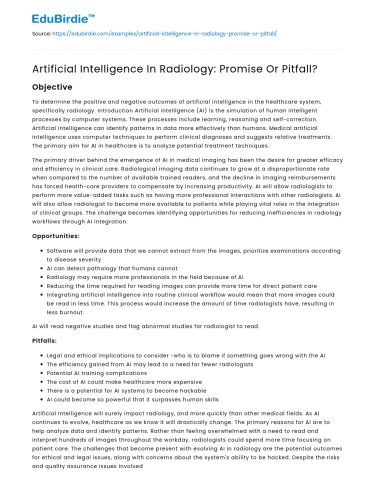Objective
To determine the positive and negative outcomes of artificial intelligence in the healthcare system, specifically radiology. Introduction Artificial intelligence (AI) is the simulation of human intelligent processes by computer systems. These processes include learning, reasoning and self-correction. Artificial intelligence can identify patterns in data more effectively than humans. Medical artificial intelligence uses computer techniques to perform clinical diagnoses and suggests relative treatments. The primary aim for AI in healthcare is to analyze potential treatment techniques.
The primary driver behind the emergence of AI in medical imaging has been the desire for greater efficacy and efficiency in clinical care. Radiological imaging data continues to grow at a disproportionate rate when compared to the number of available trained readers, and the decline in imaging reimbursements has forced health-care providers to compensate by increasing productivity. AI will allow radiologists to perform more value-added tasks such as having more professional interactions with other radiologists. AI will also allow radiologist to become more available to patients while playing vital roles in the integration of clinical groups. The challenge becomes identifying opportunities for reducing inefficiencies in radiology workflows through AI integration.
Save your time!
We can take care of your essay
- Proper editing and formatting
- Free revision, title page, and bibliography
- Flexible prices and money-back guarantee
Opportunities:
- Software will provide data that we cannot extract from the images, prioritize examinations according to disease severity
- AI can detect pathology that humans cannot
- Radiology may require more professionals in the field because of AI
- Reducing the time required for reading images can provide more time for direct patient care
- Integrating artificial intelligence into routine clinical workflow would mean that more images could be read in less time. This process would increase the amount of time radiologists have, resulting in less burnout.
AI will read negative studies and flag abnormal studies for radiologist to read.
Pitfalls:
- Legal and ethical implications to consider -who is to blame if something goes wrong with the AI
- The efficiency gained from AI may lead to a need for fewer radiologists
- Potential AI training complications
- The cost of AI could make healthcare more expensive
- There is a potential for AI systems to become hackable
- AI could become so powerful that it surpasses human skills
Artificial Intelligence will surely impact radiology, and more quickly than other medical fields. As AI continues to evolve, healthcare as we know it will drastically change. The primary reasons for AI are to help analyze data and identify patterns. Rather than feeling overwhelmed with a need to read and interpret hundreds of images throughout the workday, radiologists could spend more time focusing on patient care. The challenges that become present with evolving AI in radiology are the potential outcomes for ethical and legal issues, along with concerns about the system's ability to be hacked. Despite the risks and quality assurance issues involved in AI, it offers tremendous opportunities for changing how radiological services are delivered. It is conceivable that artificial intelligence could become more reliable, and hard-working to the radiologists.
References
- HealthITAnalytics. Benefits of Artificial Intelligence to Radiology Workflows. HealthITAnalytics. https://healthitanalytics.com/news/benefits-of-artificial-intelligence-to-radiology-workflows. Published October 14, 2019. Accessed January 31, 2020.
- Paiva OA, Prevedello LM. The potential impact of artificial intelligence in radiology. Radiologia brasileira. https://www.ncbi.nlm.nih.gov/pmc/articles/PMC5656066/. Published 2017. Accessed January 31, 2020.
- Pesapane, F., Codari, M. & Sardanelli, F. Artificial intelligence in medical imaging: threat or opportunity? Radiologists again at the forefront of innovation in medicine. Eur Radiol Exp 2, 35 (2018). https://doi.org/10.1186/s41747-018-0061-6
Did you like this example?
Make sure you submit a unique essay
Our writers will provide you with an essay sample written from scratch: any topic, any deadline, any instructions.
Cite this paper
-
APA
-
MLA
-
Harvard
-
Vancouver
Artificial Intelligence In Radiology: Promise Or Pitfall?
(2022, Jun 16). Edubirdie. Retrieved December 22, 2024, from https://edubirdie.com/examples/artificial-intelligence-in-radiology-promise-or-pitfall/
“Artificial Intelligence In Radiology: Promise Or Pitfall?” Edubirdie, 16 Jun. 2022, edubirdie.com/examples/artificial-intelligence-in-radiology-promise-or-pitfall/
Artificial Intelligence In Radiology: Promise Or Pitfall? [online].
Available at: <https://edubirdie.com/examples/artificial-intelligence-in-radiology-promise-or-pitfall/> [Accessed 22 Dec. 2024].
Artificial Intelligence In Radiology: Promise Or Pitfall? [Internet] Edubirdie.
2022 Jun 16 [cited 2024 Dec 22].
Available from: https://edubirdie.com/examples/artificial-intelligence-in-radiology-promise-or-pitfall/
copy






 Stuck on your essay?
Stuck on your essay?

